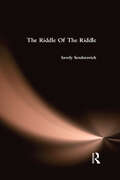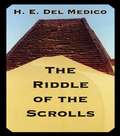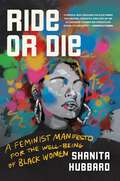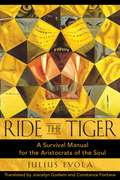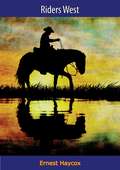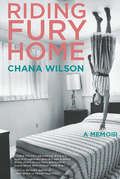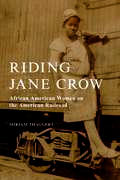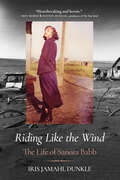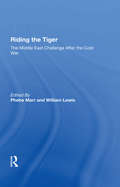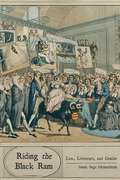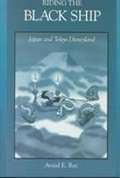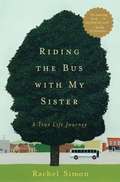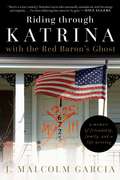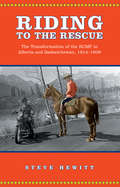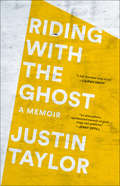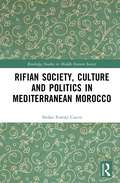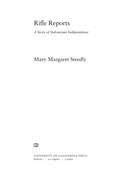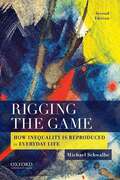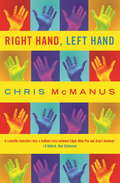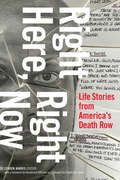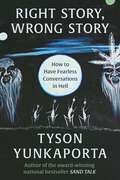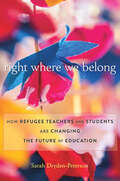- Table View
- List View
Riddle Of The Riddle
by SenderovichFirst Published in 2005. Routledge is an imprint of Taylor & Francis, an informa company.
Riddle Of The Scrolls
by DelFirst published in 2007. Routledge is an imprint of Taylor & Francis, an informa company.
Ride or Die: A Feminist Manifesto for the Well-Being of Black Women
by Shanita HubbardCultural criticism and pop culture history intertwine in this important book, which dissects how hip hop has sidelined Black women's identity and emotional well-being. A &“ride-or-die chick&” is a woman who holds down her family and community. She&’s your girl that you can call up in the middle of the night to bail you out of jail, and you know she&’ll show up and won&’t ask any questions. Her ride-or-die trope becomes a problem when she does it indiscriminately. She does anything for her family, friends, and significant other, even at the cost of her own well-being. &“No&” is not in her vocabulary. Her self-worth is connected to how much labor she can provide for others. She goes above and beyond for everyone in every aspect of her life—work, family, church, even if it&’s not reciprocated, and doesn&’t require it to be because she&’s a &“strong Black woman&” and everyone&’s favorite ride-or-die chick. To her, love should be earned, and there&’s no limit to what she&’ll do for it. In this book, author, adjunct professor of sociology, and former therapist Shanita Hubbard disrupts the ride-or-die complex and argues that this way of life has left Black women exhausted, overworked, overlooked, and feeling depleted. She suggests that Black women are susceptible to this mentality because it&’s normalized in our culture. It rings loud in your favorite hip-hop songs, and it even shows up in the most important relationship you will ever have—the one with yourself. Compassionate, candid, hard-hitting, and 100 percent unapologetic, Ride or Die melds Hubbard&’s entertaining conversations with her Black girlfriends and her personal experiences as a redeemed ride-or-die chick and a former &“captain of the build-a-brother team&” to fervently dismantle cultural norms that require Black women to take care of everyone but themselves. Ride or Die urges you to expel the myth that your self-worth is connected to how much labor you provide others and guides you toward healing. Using hip hop as a backdrop to explore norms that are harmful to Black women, Hubbard shows the ways you may be unknowingly perpetuating this harm within your relationships. This book is an urgent call for you to pull the plug on the ride-or-die chick.
Ride the Tiger: A Survival Manual for the Aristocrats of the Soul
by Joscelyn Godwin Julius Evola Constance FontanaJulius Evola’s final major work, which examines the prototype of the human being who can give absolute meaning to his or her life in a world of dissolution• Presents a powerful criticism of the idols, structures, theories, and illusions of our modern age• Reveals how to transform destructive processes into inner liberationThe organizations and institutions that, in a traditional civilization and society, would have allowed an individual to realize himself completely, to defend the principal values he recognizes as his own, and to structure his life in a clear and unambiguous way, no longer exist in the contemporary world. Everything that has come to predominate in the modern world is the direct antithesis of the world of Tradition, in which a society is ruled by principles that transcend the merely human and transitory.Ride the Tiger presents an implacable criticism of the idols, structures, theories, and illusions of our dissolute age examined in the light of the inner teachings of indestructible Tradition. Evola identifies the type of human capable of “riding the tiger,” who may transform destructive processes into inner liberation. He offers hope for those who wish to reembrace Traditionalism.
Riders West
by Ernest HaycoxA MAN ON THE PROD—A RANGE AT WARNeel St. Could, forced by his vendetta with Dan Bellew, had a plan to turn the peaceful valley into an outlaw strip ruled by flaming guns.First he put his own crooked sheriff into office. Then he imported an army of gunslicks, took over Trail City and burned out the nesters. With the remaining spreads isolated, St. Cloud made his move.And on a storm-lashed night a hundred guns fought it out—with St. Cloud and Dan Bellew clashing head-on in their own personal battle.“Fast and Breathless”—New York Times
Riding Fury Home: A Memoir
by Chana WilsonIn 1958, when Chana Wilson was seven, her mother held a rifle to her head and pulled the trigger. The gun jammed and she was taken away to a mental hospital. On her return, Chana became the caretaker of her heavily medicated, suicidal mother. It would be many years before she learned the secret of her mother’s anguish: her love affair with another married woman, and the psychiatric treatment aimed at curing her of her lesbianism. Riding Fury Homespans forty years of the intense, complex relationship between Chana and her mother-the trauma of their early years together, the transformation and joy they found when they both came out in the 1970s, and the deep bond that grew between them. From the intolerance of the '50s to the exhilaration of the women’s movement of the '70s and beyond, the book traces the profound ways in which their two lives were impacted by the social landscape of their time. Exquisitely written and devastatingly honest,Riding Fury Homeis a shattering account of one family’s struggle against homophobia and mental illness-and a powerful story of healing, forgiveness, and redemption.
Riding Jane Crow: African American Women on the American Railroad (Women, Gender, and Sexuality in American History)
by Miriam ThaggertMiriam Thaggert illuminates the stories of African American women as passengers and as workers on the nineteenth- and early-twentieth-century railroad. As Jim Crow laws became more prevalent and forced Black Americans to "ride Jim Crow" on the rails, the train compartment became a contested space of leisure and work. Riding Jane Crow examines four instances of Black female railroad travel: the travel narratives of Black female intellectuals such as Anna Julia Cooper and Mary Church Terrell; Black middle-class women who sued to ride in first class "ladies’ cars"; Black women railroad food vendors; and Black maids on Pullman trains. Thaggert argues that the railroad represented a technological advancement that was entwined with African American attempts to secure social progress. Black women's experiences on or near the railroad illustrate how American technological progress has often meant their ejection or displacement; thus, it is the Black woman who most fully measures the success of American freedom and privilege, or "progress," through her travel experiences.
Riding Like the Wind: The Life of Sanora Babb
by Iris Jamahl DunkleThis saga of a writer done dirty resurrects the silenced voice of Sanora Babb, peerless author of midcentury American literature. In 1939, when John Steinbeck's The Grapes of Wrath was published, it became an instant bestseller and a prevailing narrative in the nation's collective imagination of the era. But it also stopped the publication of another important novel, silencing a gifted writer who was more intimately connected to the true experiences of Dust Bowl migrants. In Riding Like the Wind, renowned biographer Iris Jamahl Dunkle revives the groundbreaking voice of Sanora Babb. Dunkle follows Babb from her impoverished childhood in eastern Colorado to California. There, she befriended the era's literati, including Ray Bradbury and Ralph Ellison; entered into an illegal marriage; and was blacklisted by the House Un-American Activities Committee. It was Babb's field notes and oral histories of migrant farmworkers that Steinbeck relied on to write his novel. But this is not merely a saga of literary usurping; on her own merits, Babb's impact was profound. Her life and work feature heavily in Ken Burns's award-winning documentary The Dust Bowl and inspired Kristin Hannah in her bestseller The Four Winds. Riding Like the Wind reminds us with fresh awareness that the stories we know—and who tells them—can change the way we remember history.
Riding The Tiger: The Middle East Challenge After The Cold War
by Phebe Marr William LewisThis book is the outgrowth of a collaborative effort by a small group of national security analysts associated with the Institute forNational Strategic Studies of the National Defense University,government officials responsible for pondering defense and foreign policy issues, and academics with long experience in Middle Eastern affairs. In the past several years these scholars, policy analysts, and military planners have been focusing on the impact on U.S. goals and interests in the Middle East of three seminal events-the ending of the cold war, the collapse of the Soviet Union, and the invasion of Kuwaitby Saddam Husayn and the subsequent Gulf War. The authors'individual studies have been nourished by frequent intellectual exchanges with one another and by their participation in numerous academic meetings designed to explore the future of U.S. relations with the Middle East.
Riding the Black Ram
by Susan Sage HeinzelmanHeinzelman (English, U. of Texas at Austin) juxtaposes legal and literary narratives within their historical contexts in order to demonstrate how they are mutually constitutive and in order to reveal how both narrative approaches are articulated within a nomos, as understood in Robert M. Cover's 1983 essay "Foreword: Nomos and Narrative" as the overall normative universe. However, finding Cover's regulating nomos to exclude women's experiences and to privilege male kinship relationships, she coins the term nostos as a necessary supplement to nomos that articulates its gendered nature and, in contrast to nomos's production of narratives of regulation and equity, identifies and produces otherwise unarticulated and gendered narratives of desire. Chapters discuss the juxtaposition of the Chaucer's "Man of Law's Tale" with the "Wife of Bath's Tale, the juxtaposition of 17th and 18th-century romance novels by French and English women writers with juridical narratives, how the disciplinary and generic formation and policing of novelistic and legal discourses in the 17th and 18th centuries are disturbed and gendered by Mary Delarivier Manley's 1714 novel Rivella, the operation of discursive boundaries in three narratives of a 1752 trial of a woman for the murder of her father, and the gendered and sexualized tropes found in cultural representations of three queens (including a cartoon of Queen Caroline published during her 1820 trial for treasonous adultery that depicts the queen as riding a black ram into the House of Lords, which Heinzelman reads as a metaphor for women's disruptive presence). Annotation ©2010 Book News, Inc. , Portland, OR (booknews. com)
Riding the Black Ship: Japan and Tokyo Disneyland
by Aviad E. RazIn 1996 over 16 million people visited Tokyo Disneyland, making it the most popular of the many theme parks in Japan. Since it opened in 1983, Tokyo Disneyland has been analyzed mainly as an example of the globalization of the American leisure industry and its organizational culture, particularly the "company manual." By looking at how Tokyo Disneyland is experienced by employees, management, and visitors, Aviad Raz shows that it is much more an example of successful importation, adaptation, and domestication and that it has succeeded precisely because it has become Japanese even while marketing itself as foreign. Rather than being an agent of Americanization, Tokyo Disneyland is a simulated "America" showcased by and for the Japanese. It is an "America" with a Japanese meaning.
Riding the Bus with My Sister: A True Life Journey
by Rachel SimonThis is an unusual memoir, framed by the year the author spent riding the buses of a Pennsylvania city with her sister Beth. Beth, who has mild mental retardation and lives in her own apartment, spends six days a week riding the buses from route to route. At times the author and the rest of the family are distressed by Beth's lack of purpose and ambition, and press her to get a job. When she agrees to accompany Beth on her rides, the author comes to understand how Beth has built a sense of community through her unconventional lifestyle. The various bus drivers, each portrayed as a unique individual, form a richly varied extended family for this otherwise isolated woman. In spending time with Beth riding the buses, the author opens her life to others and embarks upon her own inner journey.
Riding the Nightmare: Women and Witchcraft from the Old World to Colonial Salem
by Selma Williams Pamela Williams AdelmanSince ancient times, women practiced the art of healing with herbs, and developed a spiritual connection with the natural world. In the 15th century the Catholic Church, under threat from a variety of social upheavals in western Europe, launched an all-out attack against heretics and persons considered to be practitioners of witchcraft. For more than 200 years witches (mostly, but not wholly female) were accused, tried, and frequently put to death. The author traces the history of witchcraft, weaving in mythology about powerful women of ancient times. She shows how both Catholic and Protestant churches used the fear of witchcraft as a means to force compliance. The crusade against witches came to New England with the Puritans and reached its highest pitch in Salem, Massachusetts, in 1692.
Riding through Katrina with the Red Baron's Ghost: A Memoir of Friendship, Family, and a Life Writing
by J. Malcolm GarciaThe first book that J. Malcolm Garcia ever bought would impact his life in a way that the then twelve-year-old could have never imagined. The Day the Red Baron Died plunged Garcia into the intrigue and excitement of the World War I German flying ace's life and death. Garcia was enraptured and brimming with questions. His mother encouraged the curious boy to write to the book's author, Dale M. Titler. When the author replied, a friendship began that shaped Garcia's life. In Riding through Katrina with the Red Baron's Ghost, Garcia chronicles his relationship with Titler. It was that connection that brought Garcia to New Orleans only two weeks after Hurricane Katrina devastated the city and its citizens. Not having heard from his friend in years, Garcia made the split-second decision to go to New Orleans to try to find the man who meant so much to him. A harrowing account of New Orleans directly after Katrina?told in Garcia's award-winning journalistic style?Riding through Katrina with the Red Baron's Ghost tells a personal story of a thirty-year bond that defined a young man, as well as the universal story of the horror and devastation Katrina left in its wake.
Riding to the Rescue
by Steve HewittThe Mountie may be one of Canada's best-known national symbols, yet much of the post-nineteenth century history of the Royal Canadian Mounted Police remains unexamined, particularly the period between 1914 and 1939, when the RCMP underwent enormous transformation. The nature of this transformation as it took place in Alberta and Saskatchewan - where the Mounties have traditionally dominated policing - is the focus of Steve Hewitt's Riding to the Rescue. During the 1914-to-1939 period, the nineteenth-century model of the RCMP was evolving into a twentieth-century version, and the institution that emerged responded to a nation that was being transformed as well. Forces such as industrialization, mass immigration, urbanization, and political radicalism compelled the Mounties to look away from the frontier and toward a new era.Incorporating previously classified material, which explores the RCMP both in the context of its ordinary policing role and in its work as Canada's domestic spy agency, Hewitt demonstrates how much of the impetus behind the RCMP's transformation was ensuring its own survival and continued relevance. Riding to the Rescue is a provocative and incisive look behind one of Canada's most enduring icons at the cusp of the modern era.
Riding with the Ghost: A Memoir
by Justin TaylorAn unflinching memoir from a writer reckoning with his relationship with his troubled father and the complicated legacy that each generation hands down to the next&“Justin Taylor&’s relentless, peripatetic, and tender search for reconciliation with his late troubled father blooms into a full-throated song of joy about his own life lived through music, teaching, travel, and literature.&”—Lauren Groff, author of FloridaWhen Justin Taylor was thirty, his father, Larry, drove to the top of the Nashville airport parking garage to take his own life. Thanks to the intervention of family members, he was not successful, but the incident forever transformed how Taylor thinks of his father, and how he thinks of himself as a son.Moving back and forth in time from that day, Riding with the Ghost captures the past&’s power to shape, strengthen, and distort our visions of ourselves and one another. We see Larry as the middle child in a chilly Long Island family; as a beloved Little League coach who listens to kids with patience and curiosity; as an unemployed father struggling to keep his marriage together while battling long-term illness and depression. At the same time, Taylor explores how the work of confronting a family member&’s story forces a reckoning with your own. We see Taylor as a teacher, modeling himself after his dad&’s best qualities; as a caregiver, attempting to provide his father with emotional and financial support, but not always succeeding; as a new husband, with a dawning awareness of his own depressive tendencies.With raw intimacy, Riding with the Ghost lays bare the joys and burdens of loving a troubled family member. It&’s a memoir about fathers and sons, teachers and students, faith and illness, and the pieces of our loved ones that we carry with us always.
Rifian Society, Culture and Politics in Mediterranean Morocco (Routledge Studies in Middle Eastern Society)
by Stefan Festini CuccoThis book explores the Moroccan Rif and the city of Al Hoceima, combining local voices and ethnographic insights to provide a comprehensive and unique overview of the multifaceted dynamics of the Mediterranean region.The focus of the book is on the society, culture, and people of the region, namely the Rifians. Throughout, their voices are interwoven with first-hand ethnographic data, geographical, ethnohistorical, and anthropological insights, as well as 100 photographs, giving the reader an in-depth understanding of Rifian society and culture. The book also considers other themes, including maritime and mountain economies, ecologies in times of climatic change, transregional entanglements, migration, and the tense relationship between the Rif's inhabitants and the Moroccan monarchy. This book places particular emphasis on the generation of young Rifians who took to the streets in 2016–17 after the tragic death of a fishmonger in Al Hoceima. After months of protests involving thousands of people, at times spreading to other cities in Morocco and as far as Europe, the Makhzen, the power elite that governs Morocco, eventually took back the stage and crushed the popular protest movement. Today, despite the apparent calm, the situation in the region remains tense beneath the surface.Examining a wide range of topics related to the Rifians in northern Morocco, the book will appeal to anyone interested in the Mediterranean region, Middle Eastern society, and anthropology.
Rifle Reports
by Mary Margaret SteedlyOn August 17, 1945, Indonesia proclaimed its independence from Dutch colonial rule. Five years later, the Republic of Indonesia was recognized as a unified, sovereign state. The period in between was a time of aspiration, mobilization, and violence, in which nationalists fought to expel the Dutch while also trying to come to grips with the meaning of "independence." Rifle Reports is an ethnographic history of this extraordinary time as it was experienced on the outskirts of the nation among Karo Batak villagers in the rural highlands of North Sumatra. Based on extensive interviews and conversations with Karo veterans, Rifle Reports interweaves personal and family memories, songs and stories, memoirs and local histories, photographs and monuments, to trace the variously tangled and perhaps incompletely understood ways that Karo women and men contributed to the founding of the Indonesian nation. The routes they followed are divergent, difficult, sometimes wavering, and rarely obvious, but they are clearly marked with the signs of gender. This innovative historical study of nationalism and decolonization is an anthropological exploration of the gendering of wartime experience, as well as an inquiry into the work of storytelling as memory practice and ethnographic genre.
Rigging the Game: How Inequality is Reproduced in Everyday Life
by Michael SchwalbeIn Rigging the Game Michael Schwalbe offers a clear and compelling introduction to how the rules that shape economic life and everyday interaction generate and perpetuate inequality in American society. Guided by the questions How did the situation get this way? and How does it stay this way?, Schwalbe tracks inequality from its roots to its regulation. With its lively combination of analysis and stories, Rigging the Game is an innovative tool for teaching about the inequalities of race, class, and gender. In the final chapter, "Escaping the Inequality Trap," Schwalbe helps students understand how inequality can be challenged and overcome.
Right Actions and Good Persons: Controversies Between Eudaimonistic and Deontic Moral Theories (Routledge Revivals)
by Marjaana KopperiFirst published in 1999, this work tests the ancient against the modern in discussing whether modern approaches to ethics remain sufficiently able to provide a serious and justifiable account of morality. Marjaana Kopperi explores ancient, medieval and enlightenment philosophy to compare their notion of moral agents and ‘the good life’ with the more action-based notions of modern philosophy. Kopperi aims to examine how the promoters of agent-based ethical views deal with questions of what constitutes a good life and whether it can or should be quantified or justified.
Right Hand, Left Hand: A Special Issue Of Laterality (Special Issues Of Laterality Ser.)
by Chris McManusWinner of the Aventis Science Book Prize. 'A scientific detective story, a brilliant cross between Edgar Allan Poe and Gray's anatomy' J G Ballard, New Stateman Books of the Year'Fascinating' New Scientist'Wonderful' Nature- What is the connection between Paul McCartney, Leonardo Da Vinci and Babe Ruth?- Why are parrots and peacocks left-footed?- Do left-handers behave differently from right-handers?- Why are most people right-handed?- Why are all muppets left-handed?- Why is the heart on the left-hand side of the body?- Why is each side of the human brain so different?RIGHT HAND, LEFT HAND uses sources as diverse as the paintings of Rembrandt and the sculpture of Michelangelo, the behaviour of Canadian cichlid fish and the story of early cartography. Modern cognitive science, the history of the Wimbledon tennis championship and the biographies of great musicians are also used to explain the vast repertoire of 'left-right' symbolism that permeates our everyday lives.
Right Hand, Left Hand: The multiple award-winning true life scientific detective story
by Chris McManusWinner of the Aventis Science Book Prize. 'A scientific detective story, a brilliant cross between Edgar Allan Poe and Gray's anatomy' J G Ballard, New Stateman Books of the Year'Fascinating' New Scientist'Wonderful' Nature- What is the connection between Paul McCartney, Leonardo Da Vinci and Babe Ruth?- Why are parrots and peacocks left-footed?- Do left-handers behave differently from right-handers?- Why are most people right-handed?- Why are all muppets left-handed?- Why is the heart on the left-hand side of the body?- Why is each side of the human brain so different?RIGHT HAND, LEFT HAND uses sources as diverse as the paintings of Rembrandt and the sculpture of Michelangelo, the behaviour of Canadian cichlid fish and the story of early cartography. Modern cognitive science, the history of the Wimbledon tennis championship and the biographies of great musicians are also used to explain the vast repertoire of 'left-right' symbolism that permeates our everyday lives.
Right Here, Right Now: Life Stories from America's Death Row
by Lynden HarrisUpon receiving his execution date, one of the thousands of men living on death row in the United States had an epiphany: “All there ever is, is this moment. You, me, all of us, right here, right now, this minute, that's love.” Right Here, Right Now collects the powerful, first-person stories of dozens of men on death rows across the country. From childhood experiences living with poverty, hunger, and violence to mental illness and police misconduct to coming to terms with their executions, these men outline their struggle to maintain their connection to society and sustain the humanity that incarceration and its daily insults attempt to extinguish. By offering their hopes, dreams, aspirations, fears, failures, and wounds, the men challenge us to reconsider whether our current justice system offers actual justice or simply perpetuates the social injustices that obscure our shared humanity.
Right Story, Wrong Story: How to Have Fearless Conversations in Hell
by Tyson YunkaportaContinuing the work of the award-winning Sand Talk, Tyson Yunkaporta casts an Indigenous lens on contemporary society, challenging us to face conflict and embrace conversation to find our way onto the right track. With Right Story, Wrong Story, Apalech Clan member Tyson Yunkaporta, from far north Queensland, tackles the divisions that prevent us from talking to one another. Yunkaporta invites us to confront life’s biggest questions and arms us with the tools we need to really listen, and to open our minds to change based upon our connections with others. He makes this point through discussions with a diverse range of people across social and political divides including:liberal economistsmemorization expertsFrisian ecologistsand Elders who are wood carvers, mathematicians, and storytellers.Building upon the Indigenous tradition of “yarning” to weave our individual narratives into the great narrative that includes us all across any and all differences, Yunkaporta argues that story is at the heart of everything. But what is right or wrong story?
Right Where We Belong: How Refugee Teachers and Students Are Changing the Future of Education
by Sarah Dryden-PetersonA leading expert shows how, by learning from refugee teachers and students, we can create for displaced children—and indeed all children—better schooling and brighter futures. Half of the world’s 26 million refugees are children. Their formal education is disrupted, and their lives are too often dominated by exclusion and uncertainty about what the future holds. Even kids who have the opportunity to attend school face enormous challenges, as they struggle to integrate into unfamiliar societies and educational environments. In Right Where We Belong, Sarah Dryden-Peterson discovers that, where governments and international agencies have been stymied, refugee teachers and students themselves are leading. From open-air classrooms in Uganda to the hallways of high schools in Maine, new visions for refugee education are emerging. Dryden-Peterson introduces us to people like Jacques—a teacher who created a school for his fellow Congolese refugees in defiance of local laws—and Hassan, a Somali refugee navigating the social world of the American teenager. Drawing on more than 600 interviews in twenty-three countries, Dryden-Peterson shows how teachers and students are experimenting with flexible forms of learning. Rather than adopt the unrealistic notion that all will soon return to “normal,” these schools embrace unfamiliarity, develop students’ adaptiveness, and demonstrate how children, teachers, and community members can build supportive relationships across lines of difference. It turns out that policymakers, activists, and educators have a lot to learn from displaced children and teachers. Their stories point the way to better futures for refugee students and inspire us to reimagine education broadly, so that children everywhere are better prepared to thrive in a diverse and unpredictable world.
